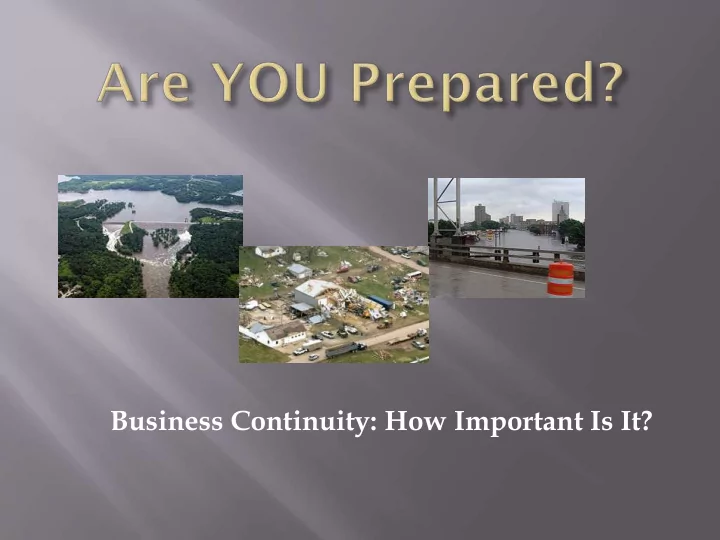

Business Continuity: How Important Is It?
Please turn on your computer speakers to listen to the audio. This webinar is being recorded and a copy will be available on the Safeguard Iowa Partnership website for future viewing. Feel free to submit questions throughout the presentation, a facilitated Q&A will take place at the end. To submit a question: enter in the question box on the right.
Understand why it’s important to plan an d prepare for potential business disruptions. Discuss the basics of creating a business continuity plan. Review the available resources for businesses.
40-60% of small businesses fail after a major emergency Small Business Administration Declared disasters more than doubled in recent years John Arens
Small businesses are a vital part of the U.S. economy: 99% of all employers 75% of net new jobs 97% of all U.S. exporters Great challenges: Money is tight Profit margins are small Susie Shapiro/FEMA Debts are high Time is short Never enough staff
“It won’t happen to ME” Small events can be just as devastating No Production Customers Sales NO BUSINESS Plan to protect your: Business Investment Livelihood
Preparedness enhances recovery from : Damages to capital assets, equipment or inventory • Business disruption • Financial losses • Loss of market share • Preparedness bolsters : Polk County EMA Business’ security • Credibility with customers, vendors, supply chain and • the community
Theft Power Outages Computer Failure Strikes Communication Fire Failure Non-access of Site Security Alert Extreme Weather Documents Flooded Supply Chain Workplace Violence Hazardous Materials Employee Sickness
Have your tools grown feet and walked out the door? Has your company gas bill doubled since last month? Does it take more time for your crews to finish work than it should? Are you ordering supplies more and more often?
Security Placement of documents Controlled shut-down Employee Sickness Strikes Cedar Rapids Gazette Fire Workplace violence 1 million individuals each year $55 million in lost wages
Non-access of site Extreme Weather Supply Chain Hazardous materials
Secure primary location Secure alternate location Select crisis manager plus backups Select spokesperson plus backups Create emergency contact list
Determine who will participate in emergency planning and crisis management Include representation from all staff Coordinate with neighbors and building management
Rank your risk against natural and man-made disasters High Medium Low What is covered by insurance? Flood insurance is different
List prioritized critical operations, staff in charge and procedures for each Facilities Suppliers, Contractors, Vendors Key Customers Employees
Know the computer hardware you own or lease Know the capacity of your IT system Document the model, serial number, date of purchase and cost for insurance records
Who will communicate emergency plans to employees? How? In a disaster, how will you communicate with employees? Create a list of emergency numbers for all employees Encourage family communication plans
What are the steps you are taking to protect your computer hardware? What are the steps you are taking to protect your computer software? What steps are you taking to protect internet connectivity?
Who is responsible for backing up critical records, including payroll and accounting systems? Are backup records, site maps, insurance policies, bank account records and other essential information stored onsite and offsite?
Review types of insurance, coverage, deductibles, policy limits Record policy numbers Are there measures or additional insurance required to keep you open for business in the event of an emergency?
Establish what employees should do if they need to leave the workplace quickly Is there a warning system? Where is the assembly site? Who will shut down the business? Who will issue the all clear to return to work? Cynthia Hunter/FEMA
Collaborate with neighboring businesses & building owners Post evacuation routes in clear view of workplace Ensure building exits are clearly marked Practice the plan, practice evacuation procedures several times a year
Establish shelter-in-place procedure to include: Warning system Shelter-in-place location Seal-the-room location Who shuts down the business Who issues the all clear to return to work
Mark a date each year to review and update your plan. Practice the plan several times a year. Incorporate key messages in new employee orientation. Encourage employees to prepare themselves & their families by getting a home emergency supply kit, creating a family emergency plan and staying informed.
Safeguard Iowa Partnership www.safeguardiowa.org sip@safeguadiowa.org 515.246.1707 Ready Business Download at www.ready.gov Order from 1-800-BE-READY
20 Weeks to Preparedness www.safeguardiowa.org/20-weeks-to-preparedness Ready America www.ready.gov or 800-BE-READY
Share your plan and procedures with employees, customers and others; encourage them to prepare Spread the word among your industry, vendors, supply chain, professional associations and customers Preparedness Pays
Please use question box on right hand side to submit your questions.
With no further questions, we will conclude the webinar. A copy of the recorded webinar will be posted on the Safeguard Iowa website – look for an e- mail sip@safeguardiowa.org
April 19 : 8:30 AM – 4 PM : Critical Infrastructure & Key Resources Workshop Registration is required. To register for the webinar/workshop go to www.safeguardiowa.org/event.
Recommend
More recommend